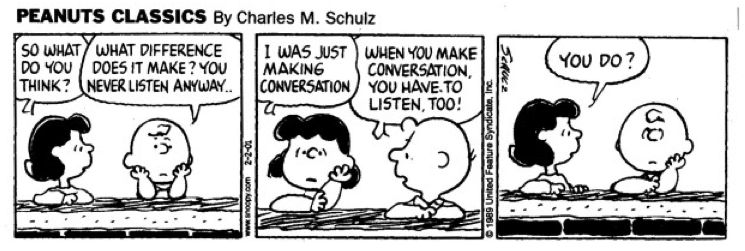Many companies produce a Net Promoter Score these days. Sadly, few have read the books that published the research that led to the Score, and as a result they are...MORE > The post Silence Is Deadly: Methods To Get...
Many companies produce a Net Promoter Score these days. Sadly, few have read the books that published the research that led to the Score, and as a result they are missing out on the real benefits that come with the Net Promoter System (and it’s the “System” in “NPS” that really matters): Stronger relationships with customers that accelerate a company’s profitable growth.
 Even worse, many companies think that merely chucking the “Recommend” question over the wall at their customers without any governance, oversight, sampling (response) strategy, or root-cause analysis to go along with it. Sure, you may find ~5-10% of the people that receive it will answer the question, but what about the other 90% that are silent?
Even worse, many companies think that merely chucking the “Recommend” question over the wall at their customers without any governance, oversight, sampling (response) strategy, or root-cause analysis to go along with it. Sure, you may find ~5-10% of the people that receive it will answer the question, but what about the other 90% that are silent?
We’ve published many articles detailing our research around silent accounts and how those customers are far more likely to churn than accounts that do provide feedback (here’s one of them, and pro tip: engaging for feedback ahead of a renewal cycle and/or QBR is an excellent method for accelerating your own results, as described in this LinkedIn discussion). The key is to get customers to WANT to give you feedback. True, you could offer “artificial” incentives like gift cards and the like, for which we’ve seen marginal boosts in customer participation in the realm of an additional 5% or so, but the best way to get something good is to put something good into it.
 So what is the good thing that you can put into it? It’s YOU. You’ve got to want the feedback. You’ve also got to want to address what they are telling you. And lastly, you’ve got to communicate effectively that you are committed to the process. Imagine what you can do if you knew exactly which customer contacts are “with” you and which aren’t, with the key reasons why:
So what is the good thing that you can put into it? It’s YOU. You’ve got to want the feedback. You’ve also got to want to address what they are telling you. And lastly, you’ve got to communicate effectively that you are committed to the process. Imagine what you can do if you knew exactly which customer contacts are “with” you and which aren’t, with the key reasons why:
B2B vendor/providers and customer/accounts working together is much like a marriage. If you never care to find out what your spouse is thinking about the relationship (and why) then the marriage is probably doomed in the long run. Even worse, imagine asking your spouse what’s bothering them but completely ignoring the response… sounds like a recipe for an even faster separation.
Here are 3 ways to show the customer you really do care with corresponding response rates that you could expect:
A live “active recruiting” discussion with each of your key stakeholders in advance of the questionnaire link being sent has produced the best results, often 80%+ response rates. The key is being able to ask the question, “Will you participate?” and since it’s live and you’ve shown your commitment to engage with them (the customer) there’s generally no push back. Over email, once sent, it’s often difficult to recover if the person doesn’t respond (especially where the account team is reaching out to stakeholders with whom there’s not already a strong relationship). Don’t re-invent the wheel: Reach out to me directly or on LinkedIn and I would be happy to assist with template(s) for asking for a live discussion and positioning the request for feedback. It’s also important to position your request in advance of the automated email with the personalized link being sent: Once the horse has left the barn it’s much more difficult to get the engagement we are looking for. In the absence of a live discussion with each of your stakeholders at the customer account, we like “delegated recruiting.” In this case you can (1) gain
In the absence of a live discussion with each of your stakeholders at the customer account, we like “delegated recruiting.” In this case you can (1) gain commitment from your customer champion to participate in a live call and then (2) forward an email to your champion and ask them to forward it on to the other contacts. This method has generally produced ~30%-60% response rates (customer participation/engagement). While it’s not as effective as the direct method where you can gauge the contacts’ feelings about the process and sell it, at least the request comes from someone that the contact in question knows and trusts, versus the perception that the request is merely from an outside vendor with whom the person may not have much of a relationship. Like above #1, reach out to me and I’m happy to provide templates.
Then we have the advance email method, where we request participation from a given contact by sending an email with the explicit “ask.” This method has tended to produce ~20% – 35% customer participation. You can also leverage a “pre-notification” template just by asking me for it, along with talking points that can be turned into a letter. That said, the difficulty here is that (1) there is no opportunity to have a discussion around who the right contacts are to include (your customers “generally always” know other colleagues that could be included to cast a wider net), and (2) as I said above, the best way to get something great from an effort is to put something great into it. IMHO This method is largely undifferentiated and doesn’t truly show your customer that your company and all employees, on a personal level, is truly committed to the process.
commitment from your customer champion to participate in a live call and then (2) forward an email to your champion and ask them to forward it on to the other contacts. This method has generally produced ~30%-60% response rates (customer participation/engagement). While it’s not as effective as the direct method where you can gauge the contacts’ feelings about the process and sell it, at least the request comes from someone that the contact in question knows and trusts, versus the perception that the request is merely from an outside vendor with whom the person may not have much of a relationship. Like above #1, reach out to me and I’m happy to provide templates.
Then we have the advance email method, where we request participation from a given contact by sending an email with the explicit “ask.” This method has tended to produce ~20% – 35% customer participation. You can also leverage a “pre-notification” template just by asking me for it, along with talking points that can be turned into a letter. That said, the difficulty here is that (1) there is no opportunity to have a discussion around who the right contacts are to include (your customers “generally always” know other colleagues that could be included to cast a wider net), and (2) as I said above, the best way to get something great from an effort is to put something great into it. IMHO This method is largely undifferentiated and doesn’t truly show your customer that your company and all employees, on a personal level, is truly committed to the process.
So what do you think: How does a mass-email to your customers show your commitment? Are there ways better than Active Listening to strengthen customer relationships? And if you’re interested in trying out what I’ve discussed here I hope you’ll leverage our proven templates by reaching out to me directly or on LinkedIn.
The post Silence Is Deadly: Methods To Get Your B2B Stakeholder Customers To Provide Feedback first appeared on Waypoint Group.










